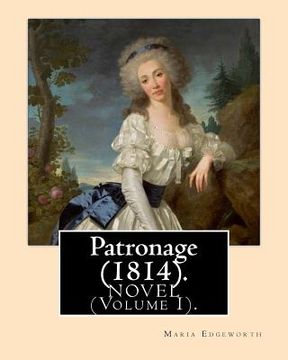Patronage (1814). NOVEL By: Maria Edgeworth (Volume I). Original Version: Patronage is a four volume fictional work by Anglo-Irish writer Maria Ed (en Inglés)
Reseña del libro "Patronage (1814). NOVEL By: Maria Edgeworth (Volume I). Original Version: Patronage is a four volume fictional work by Anglo-Irish writer Maria Ed (en Inglés)"
Patronage is a four volume fictional work by Anglo-Irish writer Maria Edgeworth and published in 1814. It is one of her later books, after such successes as Castle Rackrent (1800), Belinda (1801), Leonora (1806) and The Absentee in 1812, to name a few. The novel is a long and ambitious one which she began writing in 1809. It is the longest of her novels. Patronage as a book is path-making; it was among the first novels with a thesis and as such, it opened the way for Sir Walter Scott's historical novels. In the novel, Edgeworth focuses on and scrupulously explores the various types of patronage and the many forms it takes in all strata of English society. Despite the rigor of her analysis, Edgeworth obtains a sense of subtlety through her ingenious use of variations in characterizatons and a well diversified plot. The plot is made up of many incidents, great and small, that take the reader through a wide range of situations. Much like her contemporary, Jane Austen, Edgeworth had a gift for conveying social conventions through brilliant dialogue and acute moral observations. However, unlike Austen, Edgeworth's writing diverges into essay and an overemphasis on ideas (of which she has a large number) and veers once or twice into the didactic. The literary scholar Alastair Fowler notes her "flawless ear for speech" and ability to produce "brilliant dialogue", as well as the way her various subplots are linked by chains of causation that rest ultimately on a trivial plot element, much as Austen later was able to do so superbly. Edgeworth was eldest daughter of Richard Lovell Edgeworth, the Anglo-Irish politician, writer and inventor who had 21 other children with four wives. This book received the imprimatur of her famous father when published........ Maria Edgeworth (1 January 1768 - 22 May 1849) was a prolific Anglo-Irish writer of adults' and children's literature. She was one of the first realist writers in children's literature and was a significant figure in the evolution of the novel in Europe. She held advanced views, for a woman of her time, on estate management, politics and education, and corresponded with some of the leading literary and economic writers, including Sir Walter Scott and David Ricardo. Early life: Maria Edgeworth was born at Black Bourton, Oxfordshire. She was the second child of Richard Lovell Edgeworth (who eventually fathered 22 children by four wives) and Anna Maria Edgeworth; Maria was thus an aunt of Francis Ysidro Edgeworth. She spent her early years with her mother's family in England, until her mother's death when Maria was five. When her father married his second wife Honora Sneyd in 1773, she went with him to his estate, Edgeworthstown, in County Longford, Ireland. Maria was sent to Mrs. Lattafière's school in Derby after Honora fell ill in 1775. After Honora died in 1780 Maria's father married Honora's sister Elizabeth (then socially disapproved and legally forbidden from 1833 until the Deceased Wife's Sister's Marriage Act 1907). Maria transferred to Mrs. Devis's school in London. Her father's attention became fully focused on her in 1781 when she nearly lost her sight to an eye infection. Returning home at the age of 14, she took charge of her many younger siblings and was home-tutored in law, Irish economics and politics, science, and literature by her father. She also started her lifelong correspondences with learned men, mainly members of the Lunar Society. She became her father's assistant in managing the Edgeworthstown estate, which had become run-down during the family's 1777-1782 absence; she would live and write there for the rest of her life. With their bond strengthened, Maria and her father began a lifelong academic collaboration "of which she was the more able and nimble mind." Present at Edgeworthstown was an extended family, servants and tenants. She observed and recorded the details of daily Irish life, later drawing on this experience for her novels about t

